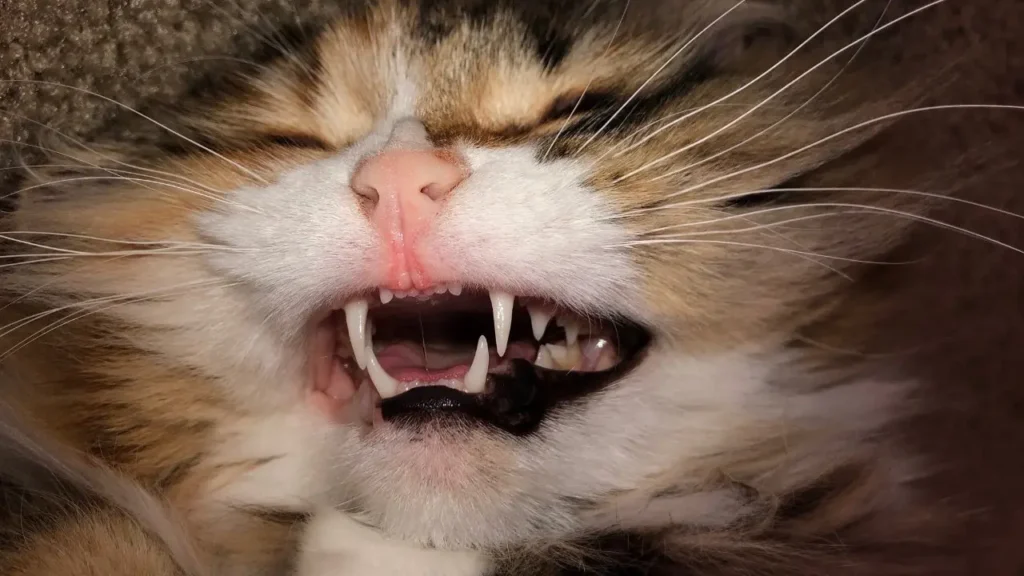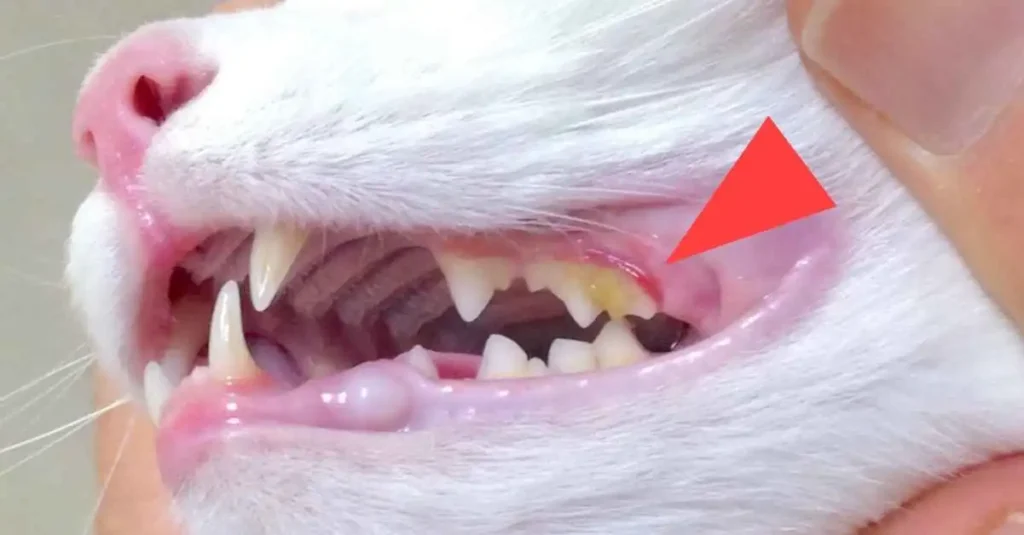If you find that your cat “does not like to eat dry food”, “has severe bad breath”, or “bleeds from teeth”, then you should pay attention to whether your cat has a “tartar” problem.
Tartar is formed by “not brushing teeth thoroughly” and the accumulation of dental plaque.
Through teeth cleaning, the “tartar”, “plaque” and “tartar” on the cat’s teeth can be removed to prevent subsequent “gingivitis”, “periodontal disease”, and even “tooth loss”.
If you do not clean cat’s teeth, in addition to dental problems, the “bacteria” hidden in the tartar may “diffusion” to other organs through the blood, which may cause more serious “inflammation” and “disease”, so it should not be underestimated.

How long does it take to clean a cat’s teeth? Check out the teeth cleaning process in one go!
Step 1: Dental examination
During the “outpatient visit”, the veterinarian will first “open their mouths” to check their “appearance”, and then “touch” and perform physical examinations to find possible problems in their oral cavity.
A very important key at this stage is to “communicate” with the owner, such as “the current condition of the oral cavity”, “what treatment is needed” and “the possible costs”.
Step 2: Preoperative health examination
After the owner confirms that he is clear about the situation, in order to “reduce the risk of anesthesia”, a “preoperative health examination” must be performed!
Preoperative health examinations can be roughly divided into: “hematological examination”, “radiological examination”, and “ultrasound examination”.
Hematology examination is the most basic health check. The main examination items include “complete blood count” and “biochemical index”, which can help understand whether the cat has “anemia”, “coagulation” problems, or whether the “liver and kidney function” is normal.
Step 3: Anesthesia
“General anesthesia” is required before surgery, which can be divided into “gas anesthesia” and “liquid anesthesia”. Usually, the anesthesiologist will “adjust the ratio of the two” according to the cat’s “health condition” and disease condition.
Anesthesia has certain risks, and different cats react to anesthesia differently, so a “complete examination” must be performed beforehand.
If the cat itself has health problems, the risk is higher, and it is recommended to inform the veterinarian in advance.
Step 4: Teeth cleaning
During teeth cleaning, the doctor will use an “ultrasonic dental cleaning machine” to “shatter” dental plaque with ultrasound, and at the same time “spray a lot of water to cool down” and “brush away dental plaque and dental plaque”.
After teeth cleaning, a “probe examination” will be performed to check whether there is still “dental plaque” and “dental plaque” in the “periodontal pocket” under the gums, or to check whether there are other problems such as “gingival atrophy” and “tooth shaking”.
Step 5: Polishing
Most owners don’t know that cats need to “polish” their teeth after teeth cleaning!
However, teeth polishing is not for the purpose of looking good, but to reduce the attachment of food residues.
Because teeth cleaning will damage the enamel on the surface of the teeth and make it uneven. If it is not polished and smoothed, food will easily remain inside, which will cause plaque and tartar to form more quickly.
Anesthesia and risks of cat teeth cleaning

🐱Is it necessary to anesthetize a cat for teeth cleaning?
The main function of anesthesia before teeth cleaning is to “relieve stress” and “relieve pain” for cats, so that the veterinarian can thoroughly clean the mouth.
If the cat is not anesthetized, it is difficult for the doctor to clean the teeth obediently, and if it moves around, it may cause injury.
And anesthesia can also “reduce” the cat’s “nervous emotions” and “pain”. You should know that pain and excessive tension are also very serious “complications” of anesthesia.
🐱What is the difference between gas anesthesia and liquid anesthesia?
Everyone thinks that gas anesthesia is very safe and liquid anesthesia is very dangerous. This is a very common myth.
We think that gas anesthesia is safe because it is “fast metabolized” and “has little burden on the liver and kidneys.”
But they have a “fatal flaw”, which is that they are “very strong vasodilators”, so they can easily cause hypotension.
In addition, gas anesthesia “has no analgesic effect”. It is like letting us fall asleep, and when we are pricked by a needle, “there will still be pain”, “heartbeat will accelerate”, and “blood pressure will rise”.
Although liquid anesthesia is “slowly metabolized”, it has “analgesic effect” and “is not likely to cause hypotension”.
There are many different liquid anesthetics. In the correct combination, “used together with gas anesthesia”, in fact, both can be used at “very low doses” to achieve “additive anesthetic effect”.
Therefore, the common gaseous anesthetics and liquid anesthetics in clinical practice are considered safe.
🐱Cat anesthesia risks
The level of anesthesia risk is a very “abstract” concept, so we need an “anesthesia risk grading scale” to help us grade and communicate.
In veterinary medicine, anesthesia risks can be divided into “levels 1-5”, with level 1 being the safest and level 5 being the most dangerous.
| Level | Symptom | Example |
| First level | Refers to cats that are healthy and have no diseases | Young healthy cats without neutering |
| Second level | Have minor systemic diseases, but the general health condition is normal | Control stable diabetes or heart disease without medication |
| Third level | Have moderate systemic disease and physical function is beginning to be affected | Unstable diabetes or heart disease that needs to be controlled |
| Fourth level | More serious systemic diseases that threaten their lives | Severe dehydration plus anemia, or kidney failure or heart failure |
| Fifth level | The animal is dying and will die within 24 hours without surgery. | Multiple organ failure, rupture of thoracic artery mass tumor or severe trauma, etc. |
Cat anesthesia teeth cleaning costs
The cost of cat anesthesia teeth cleaning basically includes several items: “blood test”, “X-ray”, “anesthesia”, “teeth cleaning”, “tooth polishing”, “tooth extraction”.
Because cats are not like humans and can use “health insurance”, the price of teeth cleaning may usually be “20,000 to 60,000” Taiwan Dollars, or even higher.
| Items | Cost |
| Blood tests | 2000-4000 Taiwan Dollars |
| X-ray | 3500-6000 Taiwan Dollars |
| Anaesthetization | 2000-3000 Taiwan Dollars/Hour |
| Teeth cleaning and polishing | 2000-5500 Taiwan Dollars |
| extract a tooth | 200-4000 yuan/piece (price may vary for different teeth) |
Things to note after teeth cleaning for cats

🐱How often do cats need teeth cleaning?
In fact, it depends on the “health status” of cats’ teeth. If they don’t have much tartar, they don’t have to have their teeth cleaned once a year.
Or if they have health concerns, it may not be suitable for annual teeth cleaning.
It is recommended to have regular oral examinations every year, and then have a veterinarian assess whether teeth cleaning is necessary!
🐱Can cats eat after teeth cleaning?
Generally speaking, it is recommended to give cats “water 2 hours after anesthesia” and “eating” after “4 hours”.
Because of anesthesia, if cats eat a lot suddenly, it is easy to cause “vomiting” and “choking”. It is recommended to feed in the form of “small and frequent meals”.
How to strengthen cats’ oral health?
🐱Regular oral examinations
It is recommended that “kittens” and small furry children “under 5 kg” should have their “first anesthetized oral examination” when they are “1 to 2 years old”.
Because many statistics have found that 70% of 2-year-old cats have periodontal diseases, which is not a minority.
🐱Regular teeth cleaning and use of dental cleaning products
It is best if you can brush your cat’s teeth every day at home!
If you don’t have time to brush your teeth, you can use passive dental cleaning products such as “dental cleaning feed” and “dental cleaning biscuits” to assist.
You can also use products such as “mouth drops” and drip them directly into the mouth to inhibit the formation of dental plaque.
